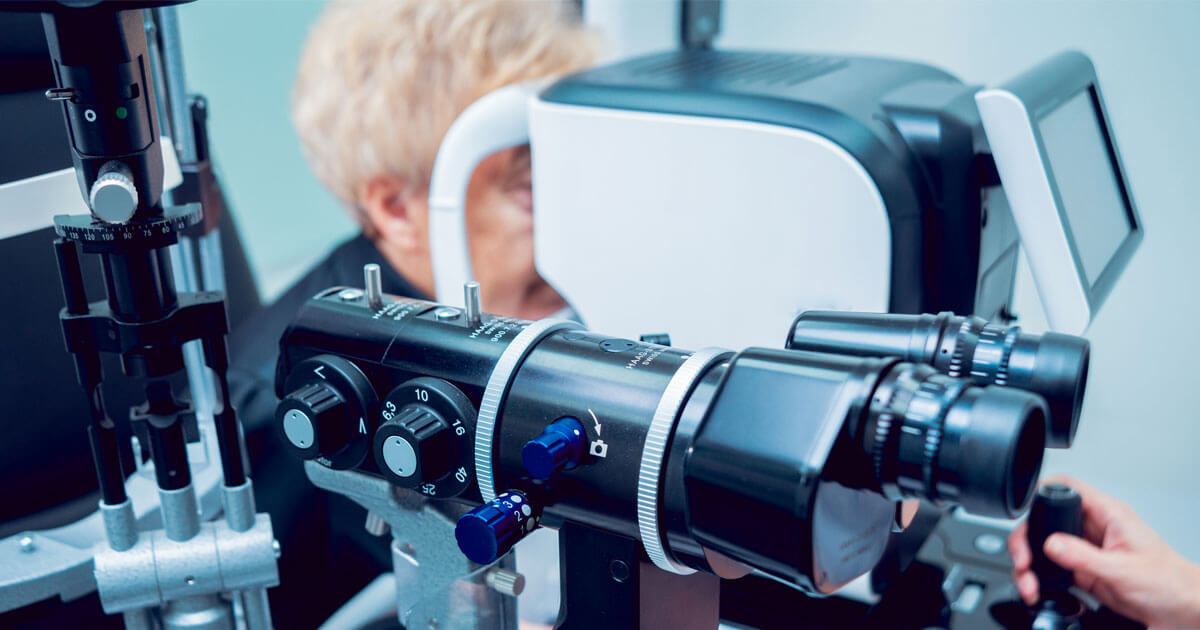
Cataract (CAUSES, SYMPTOMS AND TREATMENT)
One of the most common diseases in people over 70 years old is precisely the eye disease known as gray cataract or cataract. If you are interested in how this condition manifests itself, how it is treated or how to prevent it – in the text that follows, we provide answers to exactly those questions.
A cataract is a thick, cloudy area that forms in the lens of the eye itself. Cataracts begin when proteins in the eye form lumps and thus prevent the lens from sending a sharp image to the eye, that is, to the retina.
The retina works by converting light that passes through the lens and creating signals. After that, it sends the signals to the optic nerve, which transmits them to the brain.
Cataracts develop slowly until they begin to affect vision. There is a possibility that it may develop in both eyes, but even if it does, it usually does not occur at the same time. Cataracts are more common in older people. One study found that even more than half of people in the United States develop cataracts or undergo cataract surgery by the age of eighty.
Cataract – causes
There are several factors that increase the risk of cataracts, and only some of them are:
- Excessive production of oxidants, more precisely oxygen molecules that have changed their chemical composition due to everyday life
- Smoking
- Ultraviolet radiation
- Long-term use of steroids and other drugs
- Certain diseases such as diabetes
- Trauma
- Radiotherapy
Hear what our M.Sc. Bojan Kozomara, MD says on the topic of cataracts:
Cataract – types
There are several different types of cataracts, and they are usually divided by where in the eye and how the cataract developed. And by that we can divide them into:
- A nuclear cataract that forms in the center of the lens and causes the nucleus or center to turn yellow or brown.
- Cortical gray cataract is wedge-shaped and forms around the edges of the nucleus itself.
- Capsular cataracts form much faster than the other two types and affect the posterior part of the lens.
- Congenital gray cataract that is present at birth or forms during the first year of a baby’s life. It occurs much less often than other types that are caused by age.
- Secondary cataracts usually occur as a result of the use of certain medications, most commonly those used to treat diseases such as glaucoma and diabetes. Likewise, steroid use can sometimes cause cataracts to develop.
- A traumatic cataract occurs after an eye injury, and it can take several years before it appears.
- Radiation cataracts can be a consequence of radiation in the treatment of cancerous diseases.
If you are wondering whether a person can be too old for cataract surgery, you can find the answer in the video below:
Cataract – symptoms
As we mentioned earlier, cataracts develop very slowly, which usually means that the symptoms are barely noticeable. There’s a good chance you won’t notice anything until it starts blocking your light, and then symptoms like:
- Vision that is blurry or cloudy.
- Myopia (in the elderly)
- Changes in the way you see colors
- Problems with night driving
- Glare problems during the day
- Double images in the area of the eye affected by the cataract
- Problems with eyeglasses or contact lenses that don’t help as well as they should.

Cataract – diagnosis
In order to establish an accurate diagnosis of cataract, it is necessary for an ophthalmologist to perform a detailed eye examination, which includes an eye map test to check vision at different distances as well as tonometry to measure eye pressure.
You can schedule a general ophthalmological examination here.
The most common tonometric test is painless and uses a breath of air to flatten the cornea and in this way the eye pressure is measured. The ophthalmologist will also use drops to dilate the pupils, which makes it easier to examine the optic nerve and retina at the back of the eye to check for any damage.
Other tests that an ophthalmologist could do are tests of sensitivity to glare, but also to color perception.
Cataract – treatment
After establishing the correct diagnosis, your doctor will give you specific therapy to treat cataracts. If it is possible to correct your vision with glasses or contact lenses, your doctor will prescribe your diopter, and if this does not help and if cataracts continue to cause problems in your daily life, you may need surgery.
In case you need cataract surgery, you can schedule your appointment here.
Cataract surgery is recommended when carrying out everyday activities such as driving a car or reading becomes a problem, but also when cataracts start to interfere with treatment for some other eye problems you have.
One surgical method known as phacoemulsification involves the use of ultrasound waves to break up the lens and remove any pieces that might be in the way. In addition to this, there is also an extracapsular operation, which involves removing the cloudy part of the lens through a long incision on the cornea. After surgery, intraocular lenses are placed where the natural lenses were.
Cataract removal surgery is mostly painless, very safe, represents a permanent solution to cataract problems and has a high degree of success. If everything goes according to plan, the cataract surgery should not last more than 10 minutes, after which you should rest and “recover” from the anesthesia, which usually lasts from 30 minutes to half an hour. In most cases, patients go home the same day after surgery.
As for the recovery period after cataract surgery, it should be short and easy, as long as you follow the advice given to you by your ophthalmologist. You should provide your own transportation as you will certainly not be able to drive immediately after surgery. After the procedure, you should get protective glasses and rest for a few hours after coming home.
After removing the protection from the eye, it is possible that the vision will be a little blurry, but this should not worry you because it takes some time for your sense of vision to get used to the removal of the cataract and to adjust to the intraocular lenses that replace the natural lens. During the adaptation period, it is possible to experience short-term vision disturbances. The duration of recovery depends on the person – for some, the vision is fully sharpened in a few hours, and for others, it takes one to two weeks.
Are there any natural cures for cataracts?
When it comes to cataracts and cataract treatment, the only proven way to permanently solve this problem is to remove the cataract surgically. In order to somehow slow down the spread of the inflammatory process and other risks, you can change some lifestyle habits, which are always a good option.
Eat more fruits and vegetables because metabolism involves a process called oxidation, which can cause tissue damage throughout the body, including in the eyes. Components called antioxidants affect these processes, fresh fruits and vegetables are rich in antioxidants.
Avoid fatty, industrially processed foods because research has shown that consumption of fatty and processed foods and cataracts are closely related. This food also contributes to obesity and many other diseases, so you should avoid it anyway.
Eat more fish and seafood rich in omega 3 fatty acids which can be beneficial when it comes to your eye health.
Several studies have also shown that taking minerals and supplements can be helpful, but in any case, cataract surgery is the most effective solution that will permanently solve this health problem.
Is it possible to prevent cataracts?
To reduce the risk of cataracts, you should adopt some good habits:
Protect your eyes from UVB rays by wearing sunglasses.
You go to the ophthalmologist regularly.
Stop smoking.
Eat as many fruits and vegetables as possible.
Maintain a healthy body weight.
If you have diabetes or care for other chronic diseases, check yourself regularly and take therapy.
Cataracts, if left untreated, can lead to blindness, and although they often stop developing on their own, they cannot shrink or go away on their own. Surgical removal of cataracts is a very common procedure and is effective in as many as 90% of cases.
We hope that with this article we have managed to answer all the potential questions or doubts you may have had regarding the term gray cataract or cataract. Below we recommend you also read: What is Glaucoma? (CAUSES, SYMPTOMS AND TREATMENT)
Take our quick test to find out if laser eye surgery is your path to glasses-free vision
Not all laser eye surgery options are the same. Find out which one is right for you by taking our quick 2-minute self-test
Our most popular procedures
What our patients say...

★ ★ ★ ★ ★
“All praise, expertise and kindness of the entire staff headed by Kozomara
"

★ ★ ★ ★ ★
“I turn to Kozomar ophthalmology with great pleasure, even though I came from Slovenia for their services. I am extremely grateful for their professional treatment during diopter removal and blepharoplasty. Every time I am impressed by their dedicated and precise work. I would especially like to emphasize the respectable attitude of the entire staff”

★ ★ ★ ★ ★
“All the best! Very satisfied with everything, from the appointment, examination, operation and control. Thank you to the doctor and the whole team for their expertise and kindness!!!”

★ ★ ★ ★ ★
“It is with great pleasure that I thank the entire staff and dr. Kosamora. I am very satisfied with the service, I came yesterday with very poor eyesight. They restored my vision to 100% painlessly, quickly and professionally. I recommend this clinic to everyone and THANK YOU very much. Sincerely, Adnan Jusić.”

★ ★ ★ ★ ★
“Congratulations, I've done several procedures so far, from aesthetics to vision correction. I'm over the moon! Kudos!”

★ ★ ★ ★ ★
“Very friendly staff, medical specialists and technology of the highest quality”

★ ★ ★ ★ ★“I found out about the clinic from a friend. The professionalism during the examination and the kindness of the entire staff, after two or three days they create an almost friendly relationship with the patients.”

★ ★ ★ ★ ★“Laser dioptre removal done in 3/23. Service at the level, wonderful and very kind staff. Everything was as it was said at the examinations. Clear vision from the first day, thank you from the bottom of my heart! ????”

★ ★ ★ ★ ★
“Excellent team, kindness and professionalism! All recommendations!”

★ ★ ★ ★ ★
“Very friendly and competent team!
Dr. Kozomara, himself is a top professional! I felt very well looked after. Was fully explained. I've been watching in HD quality for a few days now
Thank you very much!!!”
We have replaced the images of the actual patients who provided these testimonials to protect their privacy

